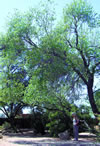Desert willow
Chilopsis linearis
A deciduous willow-like tree
growing up to 30 ft, with slender leaves and long
slim pods. Fragrant, trumpet-shaped, pink to
lavender flowers attract hummingbirds and other
pollinators. Desert willow blooms throughout the
spring and summer and grows fast with supplemental
irrigation. |
 |
Desert ironwood
Olneya tesota
The most drought-tolerant of
our native trees, growing up to 40 ft tall. The
pink, white or lavender flowers are arranged in
loose clusters that bloom in May and June. Pods
containing edible seeds ripen 5-8 weeks later. The
small gray-green leaves and upright form readily
distinguish desert ironwood from other desert trees.
An important “nurse” tree for saguaros and other
plants, ironwoods also provide shade for desert
animals. |
 |
Also try:
Baby bonnets
Coursetia glandulosa
A large, airy, thornless shrub
with delicate pea-shaped white, yellow
and pink flowers. |
|